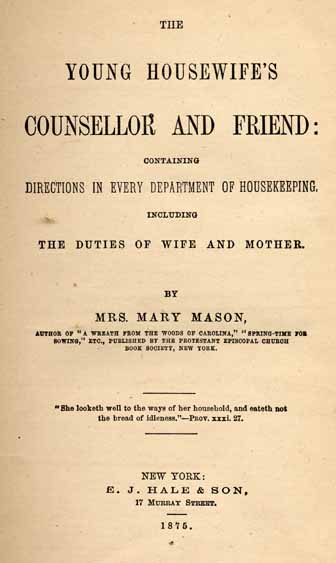Haley Murdock

Mary Ann Bryan Mason, The Young Housewife’s Counsellor and Friend: Containing Directions in Every Department of Housekeeping. Including the Duties of Wife and Mother (New York: E.J. Hale and Son, 1875), Call number C641.5 M41y (North Carolina Collection, University of North Carolina at Chapel Hill), https://docsouth.unc.edu/nc/mason/mason.html#p246.
The technique of pickling was prominent in the time period of 19th century expansion. Though pickling was invented long before this time, it is important to note the continuance of this practice and the reasoning behind it. This is indicative of a time when fresh foods were not readily available year-round. It also demonstrates the value of conservation that is a great focus in the foodways of this time period. As pickling was common practice, this technique was described in great detail in Mary Ann Bryan Mason’s book Mrs. Mason’s New Cookery (Previously published under the title The Young Housewife’s Counsellor and Friend: Containing Directions in Every Department of Housekeeping)[1]. This was a book that contained food recipes and common practices surrounding life in the household.
Pickling, as outlined in Mason’s work, is a practice that can be used to preserve various foods, particularly vegetables, in a mixture of vinegar and spices. For example, Mason suggests soaking and steaming vegetables such as cucumbers and tomatoes in salt and water with layers of vine or mustard leaves in a kettle. Then these are to be placed in a stone jar with alternating layers of spices such as mustard, horseradish and celery seed, then closed tightly[2].
The author, Mary Ann Bryan Mason, was born in New Bern, NC, but her family was prominent in Raleigh[3]. Therefore, it can be assumed that her work was in circulation in Chapel Hill, just one county over. This source can be used to show the conventions of the time it was written, 1875, and the time period thereafter. The book would be indicative of civil code for women at the time in North Carolina, even the Chapel Hill area, because Mason’s role was that of a housewife and hostess.
It is different from previous eras because pickling and preserving was before just considered a practice. Its inclusion in Mason’s book is significant in that pickling became defined and validated as a foodway of the nineteenth century. In the eras that followed, fresh foods and mass production became more prominent. The food industry was transformed with the Industrial Revolution in the following century and the expansion of markets beyond locally grown food. Through the vicissitudes of the following century, having pickled foods would at times continue to be a necessary staple in the diets of North Carolinians, and at other times, it would carry on as a tradition for the purposes of taste and sense of family and community.
[1] Mary Ann Bryan Mason, Mrs. Mason’s New Cookery (New York: E.J. Hale and Son, 1875), Call number C641.5 M41y (North Carolina Collection, University of North Carolina at Chapel Hill), p. 246, https://docsouth.unc.edu/nc/mason/mason.html#p246.
[2] Mason, Mrs. Mason’s New Cookery, p. 246.
[3] Richard Walser, “Mason, Mary Ann Bryan, 1802-1881,” Documenting the American South, accessed October 1, 2018. Accessed from https://docsouth.unc.edu/nc/mason/bio.html.